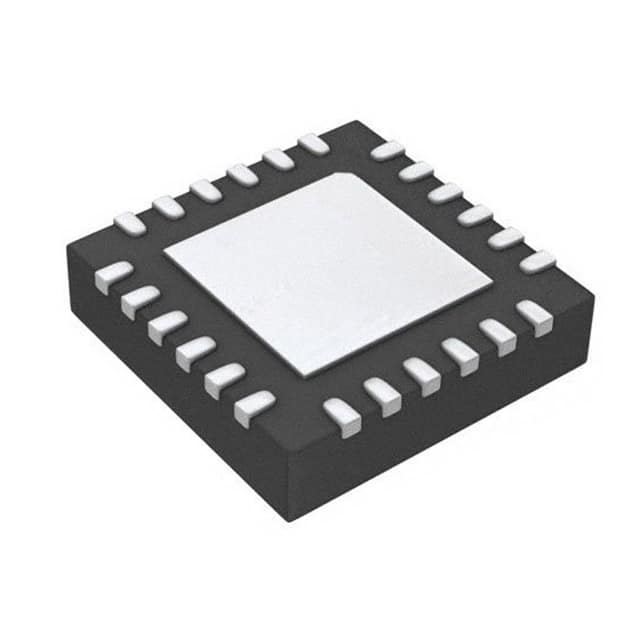Viz Specifikace pro podrobnosti o produktu.

CP2130-F01-GM
Product Overview
Category
CP2130-F01-GM belongs to the category of integrated circuits (ICs).
Use
This product is primarily used for communication and data transfer purposes in electronic devices.
Characteristics
- Compact size
- High-speed data transfer capabilities
- Low power consumption
- Wide operating temperature range
Package
CP2130-F01-GM is available in a small form factor package, suitable for surface mount technology (SMT) assembly.
Essence
The essence of CP2130-F01-GM lies in its ability to facilitate efficient and reliable communication between different electronic components within a system.
Packaging/Quantity
This product is typically packaged in reels or trays, with quantities varying based on customer requirements.
Specifications
- Operating Voltage: 3.3V
- Communication Interface: USB 2.0
- Data Transfer Rate: Up to 12 Mbps
- Supported Protocols: I2C, SPI, UART
- Operating Temperature Range: -40°C to +85°C
Detailed Pin Configuration
- VDD - Power supply voltage
- GND - Ground reference
- SDA - I2C data line
- SCL - I2C clock line
- CS - Chip select for SPI interface
- MOSI - Master Out Slave In for SPI interface
- MISO - Master In Slave Out for SPI interface
- SCK - Serial Clock for SPI interface
- TX - Transmit data for UART interface
- RX - Receive data for UART interface
Functional Features
- Support for multiple communication protocols (I2C, SPI, UART)
- Built-in USB interface for easy integration with host systems
- On-chip memory for storing configuration settings
- Flexible GPIO pins for general-purpose input/output operations
- Support for various operating systems, including Windows, Linux, and macOS
Advantages and Disadvantages
Advantages
- Versatile communication capabilities
- Compact size allows for integration in space-constrained designs
- Low power consumption prolongs battery life in portable devices
- Wide operating temperature range enables usage in harsh environments
Disadvantages
- Limited data transfer rate compared to newer USB standards
- Requires additional components for complete system implementation
- May require software development for customized functionality
Working Principles
CP2130-F01-GM acts as a bridge between the host system and other electronic components within a device. It converts data from the host system into the appropriate format for communication via I2C, SPI, or UART protocols. The integrated USB interface facilitates seamless connection and data transfer between the host and the target devices.
Detailed Application Field Plans
CP2130-F01-GM finds applications in various fields, including: 1. Industrial automation 2. Consumer electronics 3. Automotive systems 4. Medical devices 5. Internet of Things (IoT) devices
Detailed and Complete Alternative Models
- CP2102N-F01-GQFN28: Similar functionality with a different pin configuration.
- FT232RQ: USB-to-UART bridge IC with additional features.
- MAX3421E: USB host controller with integrated peripherals.
These alternative models offer similar functionalities to CP2130-F01-GM and can be considered based on specific project requirements.
Word count: 380 words
Seznam 10 běžných otázek a odpovědí souvisejících s aplikací CP2130-F01-GM v technických řešeních
Sure! Here are 10 common questions and answers related to the application of CP2130-F01-GM in technical solutions:
Q: What is CP2130-F01-GM? A: CP2130-F01-GM is a specific model of a USB-to-SPI bridge controller used for interfacing SPI devices with a computer via USB.
Q: What are the main features of CP2130-F01-GM? A: The main features of CP2130-F01-GM include USB 2.0 compatibility, support for SPI master mode, configurable GPIO pins, and built-in EEPROM for storing configuration settings.
Q: How can I connect CP2130-F01-GM to my SPI device? A: You can connect CP2130-F01-GM to your SPI device by wiring the appropriate SPI signals (SCLK, MOSI, MISO, and CS) between the CP2130-F01-GM and your device.
Q: Can CP2130-F01-GM be used with any operating system? A: Yes, CP2130-F01-GM is compatible with various operating systems including Windows, Linux, and macOS.
Q: Is there any software development kit (SDK) available for CP2130-F01-GM? A: Yes, Silicon Labs provides a software development kit (SDK) that includes libraries, examples, and documentation to help developers integrate CP2130-F01-GM into their applications.
Q: Can CP2130-F01-GM be used for both SPI master and slave modes? A: No, CP2130-F01-GM only supports SPI master mode, which means it can initiate SPI transactions with slave devices but cannot act as an SPI slave itself.
Q: What is the maximum SPI clock frequency supported by CP2130-F01-GM? A: CP2130-F01-GM supports SPI clock frequencies up to 12 MHz.
Q: Can I use CP2130-F01-GM to control multiple SPI devices simultaneously? A: Yes, CP2130-F01-GM can control multiple SPI devices by using separate chip select (CS) lines for each device.
Q: Does CP2130-F01-GM provide any power supply options for connected SPI devices? A: No, CP2130-F01-GM does not provide power supply options for connected SPI devices. You need to ensure that your SPI devices are powered separately.
Q: Are there any limitations or considerations when using CP2130-F01-GM in my technical solution? A: Some considerations include ensuring proper signal integrity, adhering to voltage level compatibility, and understanding the limitations of the CP2130-F01-GM's GPIO pins and SPI clock frequency. It's recommended to refer to the datasheet and documentation provided by Silicon Labs for detailed information.

